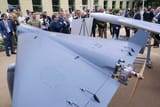Search Results
7/21/2025, 2:41:46 PM
"A nightmare for Russia and China"
It appears that LUCAS will have the ability to operate cooperatively and autonomously with other similar drones, making it ideal for swarming missions, a tactic already used effectively by Russian and Iranian forces in the Ukrainian theater of operations.
One of LUCAS's distinguishing features is its integration with the MUSIC (Multi-domain Unmanned Systems Integrated Communications) network, allowing it to act as an airborne communications node, ensuring secure and continuous connectivity between ground, air, and maritime units even in environments with intense electronic jamming or GPS denial. This capability reinforces its applicability in scenarios such as the Indo-Pacific, where distributed maritime operations doctrine requires resilience and flexibility.
LUCAS goes further by incorporating reusability capabilities, real-time control, onboard artificial intelligence, and modularity—allowing it to be quickly adapted to different missions and threats.
The introduction of LUCAS aligns with the U.S. Department of Defense's "Replicator" program, which envisions the mass production of expendable, autonomous drones to address the growing threat of high-intensity conflicts and aerial saturation.
The drone is expected to be deployed in U.S. Indo-Pacific Command (USINDOPACOM) missions, particularly in naval and amphibious operations, where its coordinated strike capability and low operational cost are crucial.
It appears that LUCAS will have the ability to operate cooperatively and autonomously with other similar drones, making it ideal for swarming missions, a tactic already used effectively by Russian and Iranian forces in the Ukrainian theater of operations.
One of LUCAS's distinguishing features is its integration with the MUSIC (Multi-domain Unmanned Systems Integrated Communications) network, allowing it to act as an airborne communications node, ensuring secure and continuous connectivity between ground, air, and maritime units even in environments with intense electronic jamming or GPS denial. This capability reinforces its applicability in scenarios such as the Indo-Pacific, where distributed maritime operations doctrine requires resilience and flexibility.
LUCAS goes further by incorporating reusability capabilities, real-time control, onboard artificial intelligence, and modularity—allowing it to be quickly adapted to different missions and threats.
The introduction of LUCAS aligns with the U.S. Department of Defense's "Replicator" program, which envisions the mass production of expendable, autonomous drones to address the growing threat of high-intensity conflicts and aerial saturation.
The drone is expected to be deployed in U.S. Indo-Pacific Command (USINDOPACOM) missions, particularly in naval and amphibious operations, where its coordinated strike capability and low operational cost are crucial.
Page 1
